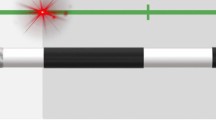Abstract
The purpose of this study was to compare the effectiveness of 1470- and 980-nm lasers with regard to power output, complications, recanalization rates, and treatment response. We prospectively evaluated the effectiveness of endovenous laser ablation (EVLA) in a total of 152 great and small saphenous veins from 96 patients. Lasers were randomly used based on the availability of the units. Patients were clinically evaluated for Clinical Etiologic Anatomic Pathophysiologic (CEAP) stage and examined with Doppler ultrasound. Treatment response was determined anatomically by occlusion of the vein and clinically by the change in the venous clinical severity score (VCSS). Seventy-eight of the saphenous veins underwent EVLA with a 980-nm laser and 74 underwent EVLA with a 1470-nm laser. Treatment response was (68) 87.2 % in the 980-nm group and (74) 100 % in the 1470-nm group (p = 0.004). The median VCSS decreased from 4 to 2 in the 980-nm group (p < 0.001) and from 8 to 2 (p < 0.001) in the 1470-nm group. At 1-year follow-up, seven veins treated with 980 nm and two veins treated with 1470 nm were recanalized (p = 0.16); the average linear endovenous energy density (LEED) was 83.9 (r, 55–100) J/cm and 58.5 (r, 45–115) J/cm, respectively (p < 0.001). Postoperative minor complications occurred in 23 (29.4 %) limbs in the 980-nm group and in 19 (25.6 %) limbs of the 1470-nm group (p = 0.73). EVLA with the 1470-nm laser have less energy deposition for occlusion and better treatment response.
Similar content being viewed by others
References
Shepherd AC, Gohel MS, Brown LC, Metcalfe MJ, Hamish M, Davies AH (2010) Randomized clinical trial of VNUS ClosureFAST radiofrequency ablation versus laser for varicose veins. Br J Surg 97:810–818
Oguzkurt L (2012) Ultrasonographic anatomy of the lower extremity superficial veins. Diagn Interv Radiol 18:423–430
Rasmussen LH, Lawaetz M, Bjoern L, Vennits B, Blemings A, Eklof B (2011) Randomized clinical trial comparing endovenous laser ablation, radiofrequency ablation, foam sclerotherapy and surgical stripping for great saphenous varicose veins. Br J Surg 98:1079–1087
Delaney CL, Russell DA, Iannos J, Spark JI (2012) Is endovenous laser ablation possible while taking warfarin? Phlebology 27:231–234
Darwood RJ, Gough MJ (2009) Endovenous laser treatment for uncomplicated varicose veins. Phlebology 24:50–61
Vasquez MA, Munschauer CE (2012) Revised venous clinical severity score: a facile measurement of outcomes in venous disease. Phlebology 27:119–129
Massaki AB, Kiripolsky MG, Detwiler SP, Goldman MP (2013) Endoluminal laser delivery mode and wavelength effects on varicose veins in an ex vivo model. Lasers Surg Med 45:123–129
Koroglu M, Eris HN, Aktas AR, Kayan M, Yeşildağ A, Cetin M et al (2011) Endovenous laser ablation and foam sclerotherapy for varicose veins: does the presence of perforating vein insufficiency affect the treatment outcome? Acta Radiol 52:278–284
Hennings T, Hennings D, Lindsay C (2014) Thrombus formation using endovenous lasers: an in vitro experiment. Phlebology 29:171–178
Kansaku R, Sakakibara N, Amano A, Endo H, Shimabukuro T, Sueishi M (2014) Histological difference between pulsed wave laser and continuous wave laser in endovenous laser ablation. Phlebology. doi:10.1177/0268355514538248
Sufian S, Arnez A, Labropoulos N, Lakhanpal S (2014) Endovenous heat-induced thrombosis after ablation with 1470 nm laser: incidence, progression, and risk factors. Phlebology. doi:10.1177/0268355514526588
Tarhan IA, Dumantepe M, Yurdakul I, Kehlibar T, Ozler A (2014) Local cooling effect on perforation rates comparing the 980–1470 nm laser wavelengths used with endovenous laser ablation: double blind in vitro experimental study. Phlebology 29:120–125
Almeida J, Mackay E, Javier J, Mauriello J, Raines J (2009) Saphenous laser ablation at 1470 nm targets the vein wall, not blood. Vasc Endovasc Surg 43:467–472
van den Bos RR, van Ruijven PW, van der Geld CW, van Gemert MJ, Neumann HA, Nijsten T (2012) Endovenous simulated laser experiments at 940 nm and 1470 nm suggest wavelength-independent temperature profiles. Eur J Vasc Endovasc Surg 44:77–81
Özkan U, Saritürk Ç (2012) Early clinical improvement in chronic venous insufficiency symptoms after laser ablation of saphenous veins. Diagn Interv Radiol 18:594–598
Zerweck C, von Hodenberg E, Knittel M, Zeller T, Schwarz T (2014) Endovenous laser ablation of varicose perforating veins with the 1470-nm diode laser using the radial fibre slim. Phlebology 29:30–36
Malskat WS, Stokbroekx MA, van der Geld CW, Nijsten TE, van den Bos RR (2014) Temperature profiles of 980- and 1470-nm endovenous laser ablation, endovenous radiofrequency ablation and endovenous steam ablation. Lasers Med Sci 29:423–429
Theivacumar NS, Dellagrammaticas D, Darwood RJ, Mavor AI, Gough MJ (2008) Fate of the great saphenous vein following endovenous laser ablation: does re-canalisation mean recurrence? Eur J Vasc Endovasc Surg 36:211–215
von Hodenberg E, Zerweck C, Knittel M, Zeller T, Schwarz T (2013) Endovenous laser ablation of varicose veins with the 1470 nm diode laser using a radial fiber—1-year follow-up. Phlebology. doi:10.1177/0268355513512825
Dumantepe M, Uyar I (2013) Comparing cold and warm tumescent anesthesia for pain perception during and after the endovenous laser ablation procedure with 1470 nm diode laser. Phlebology. doi:10.1177/0268355513512827
Can Caliskan K, Cakmakci E, Celebi I, Basak M (2013) Endovenous1470 nm laser treatment of the saphenous vein: early report of pain assessment. J Cardiovasc Surg 54:263–267
Duman E, Yildirim E, Saba T, Ozulku M, Gunday M, Coban G (2013) The effect of laser wavelength on postoperative pain score in the endovenous ablation of saphenous vein insufficiency. Diagn Interv Radiol 19:326–329
Acknowledgments
We thank Evrim Erdemoglu, MD, for his valuable help in the statistical analyses of our data.
Conflict of interest
The authors declare that they have no conflict of interest.
Author information
Authors and Affiliations
Corresponding author
Rights and permissions
About this article
Cite this article
Aktas, A.R., Celik, O., Ozkan, U. et al. Comparing 1470- and 980-nm diode lasers for endovenous ablation treatments. Lasers Med Sci 30, 1583–1587 (2015). https://doi.org/10.1007/s10103-015-1768-8
Received:
Accepted:
Published:
Issue Date:
DOI: https://doi.org/10.1007/s10103-015-1768-8




